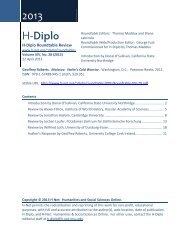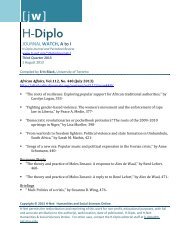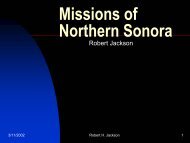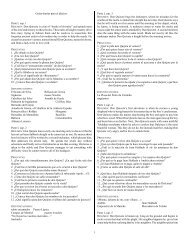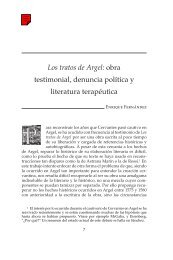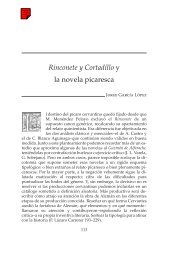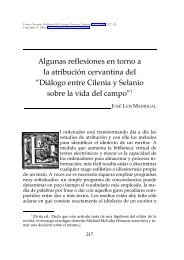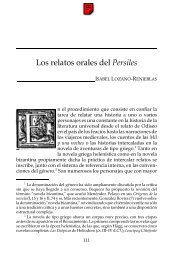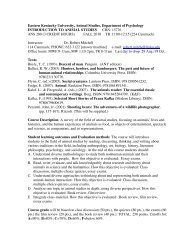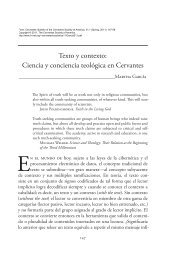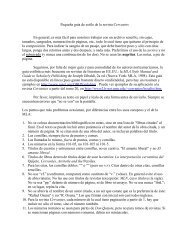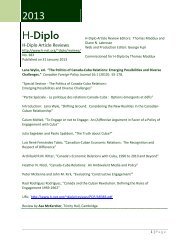H-Diplo Roundtable on Martin Thomas. Violence and ... - H-Net
H-Diplo Roundtable on Martin Thomas. Violence and ... - H-Net
H-Diplo Roundtable on Martin Thomas. Violence and ... - H-Net
You also want an ePaper? Increase the reach of your titles
YUMPU automatically turns print PDFs into web optimized ePapers that Google loves.
H-<str<strong>on</strong>g>Diplo</str<strong>on</strong>g> <str<strong>on</strong>g>Roundtable</str<strong>on</strong>g> Reviews, Vol. XV, No. 5 (2013)<br />
<strong>Thomas</strong> does not dispute such differences but digs deeper to argue that scholars have<br />
neglected political ec<strong>on</strong>omy in favor of cultural, social, <strong>and</strong> especially political factors. He<br />
argues that political ec<strong>on</strong>omy was crucially determinative of col<strong>on</strong>ial policing: “police<br />
operati<strong>on</strong>s reflected not just the col<strong>on</strong>ial political order but its ec<strong>on</strong>omic structures as well”<br />
(25). Strikes by industrial workers (by which <strong>Thomas</strong> means plantati<strong>on</strong> laborers, mine<br />
workers, stevedores, <strong>and</strong> so forth) <strong>and</strong> workplace management issues were of increasing<br />
c<strong>on</strong>cern to the col<strong>on</strong>ial powers from 1918-1940. As workplace regulati<strong>on</strong> grew in<br />
importance, the “ec<strong>on</strong>omic c<strong>on</strong>figurati<strong>on</strong> of individual col<strong>on</strong>ies” shaped the kind of policing<br />
that developed across the British, French, <strong>and</strong> Belgian empires (2).<br />
Take for example the otherwise unrelated cases of Vietnam <strong>and</strong> Sierra Le<strong>on</strong>e. They were<br />
similar in that a preoccupati<strong>on</strong> in each with the producti<strong>on</strong> of <strong>on</strong>e paramount raw material,<br />
rubber <strong>and</strong> diam<strong>on</strong>ds respectively, shaped policing to protect business interests <strong>and</strong>,<br />
ultimately, col<strong>on</strong>ial revenues. In Vietnam, “despite the vociferousness of new-style anticol<strong>on</strong>ialism<br />
. . . the focus of repressive policing lay elsewhere: in col<strong>on</strong>ial Vietnam’s fastestgrowing<br />
export industry, rubber producti<strong>on</strong> in the southern col<strong>on</strong>y of Cochin-China” (145).<br />
Likewise, “Securing Sierra Le<strong>on</strong>e’s minefields, m<strong>on</strong>itoring their workforce <strong>and</strong> inhibiting<br />
black market trading occasi<strong>on</strong>ed more police work than anything else during the 1930s,<br />
despite the ferment of proto-nati<strong>on</strong>alist oppositi<strong>on</strong> in Freetown” (276). Multiplying case<br />
studies bey<strong>on</strong>d Sierra Le<strong>on</strong>e <strong>and</strong> Vietnam, <strong>Thomas</strong> claims that “For all the nati<strong>on</strong>al <strong>and</strong><br />
regi<strong>on</strong>al variati<strong>on</strong>s encountered within <strong>and</strong> between the col<strong>on</strong>ies studied, what emerge are<br />
shared preoccupati<strong>on</strong>s <strong>and</strong> similar patterns in the maintenance of European col<strong>on</strong>ial order<br />
between the wars” (13). He justifies his claim with a stunning comparative underpinning,<br />
incorporating incisive local studies from Morocco, Algeria, Tunisia, Vietnam, Malaya,<br />
Jamaica, Trinidad, British Guiana, Sierra Le<strong>on</strong>e, Nigeria, <strong>and</strong> the Belgian C<strong>on</strong>go.<br />
The wealth of studies in <strong>Thomas</strong>’s book inevitably raises the questi<strong>on</strong> about which cases he<br />
passes over. How persuasive would <strong>Thomas</strong>’s recalibrati<strong>on</strong> be—i.e., more attenti<strong>on</strong> to<br />
political ec<strong>on</strong>omy relative to politics, especially nati<strong>on</strong>alism—if his analysis extended to<br />
India, the col<strong>on</strong>y with the most well-developed nati<strong>on</strong>alist movement by the 1920s <strong>and</strong><br />
1930s? What about Soviet Russia’s l<strong>and</strong>-based empire? Reading <strong>Violence</strong> <strong>and</strong> Col<strong>on</strong>ial Order<br />
reminds me of the importance given more recently to political ec<strong>on</strong>omy when c<strong>on</strong>sidering<br />
the Gulag’s expansi<strong>on</strong> during the exact period <strong>Thomas</strong> examines. Policing dissent within<br />
Russia’s far-flung c<strong>on</strong>tiguous empire—even developments as traumatic as the 1937-1938<br />
Great Terror—looks quite different when viewed bey<strong>on</strong>d politics. What comes clearly into<br />
focus in the mass arrests <strong>and</strong> impris<strong>on</strong>ments beginning with the Bolshevik Revoluti<strong>on</strong> into<br />
the 1950s is the drive to populate Russia’s north <strong>and</strong> east in order to extract raw materials<br />
like timber <strong>and</strong> gold for export. 1 So why did <strong>Thomas</strong> exclude both India <strong>and</strong> Russia? Such a<br />
questi<strong>on</strong> would be largely impertinent if not posed facetiously, as is the case here. The<br />
already vast geographic <strong>and</strong> archival scope of <strong>Violence</strong> <strong>and</strong> Col<strong>on</strong>ial Order places it in the<br />
realm of wide-ranging achievements such as Odd Arne Westad’s The Global Cold War. 2<br />
1 Anne Applebaum, Gulag: A History (New York: Anchor Books, 2003).<br />
2 Odd Arne Westad, The Global Cold War: Third World Interventi<strong>on</strong>s <strong>and</strong> the Making of our Times<br />
(Cambridge: Cambridge University Press, 2006).<br />
20 | P age



